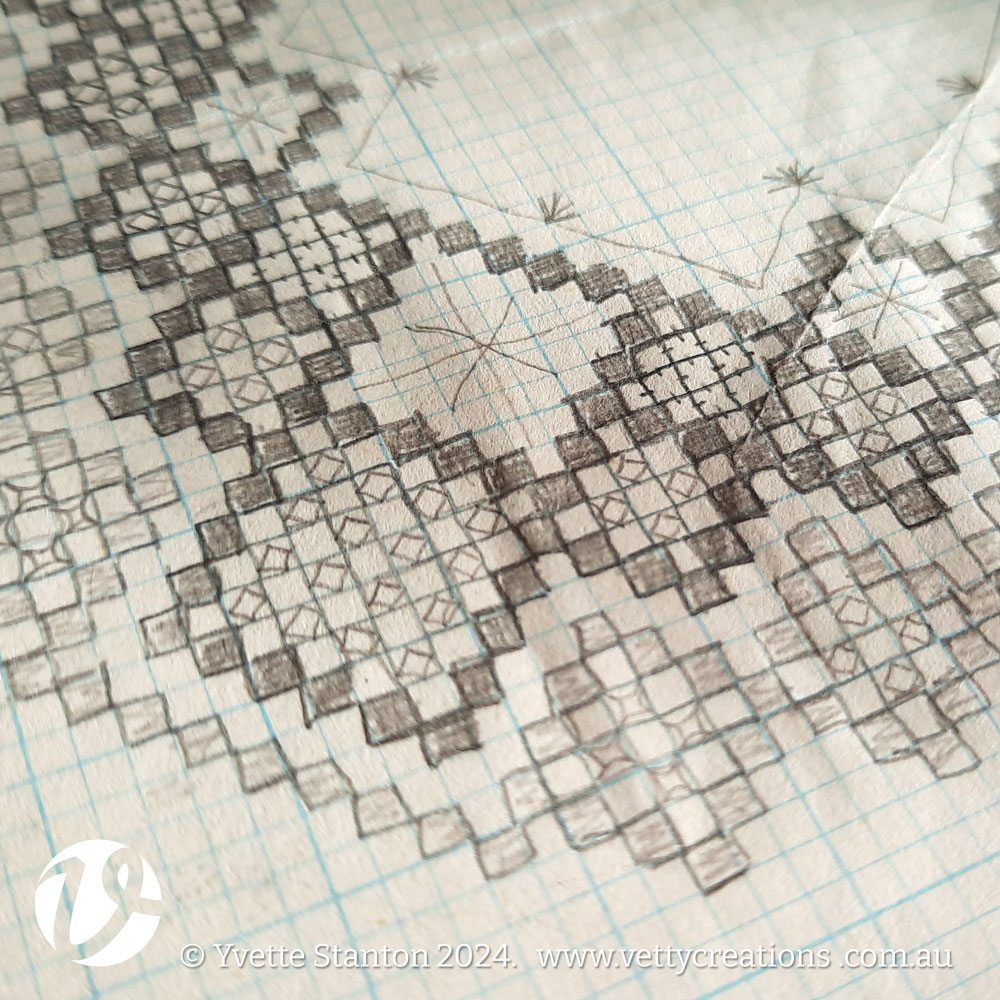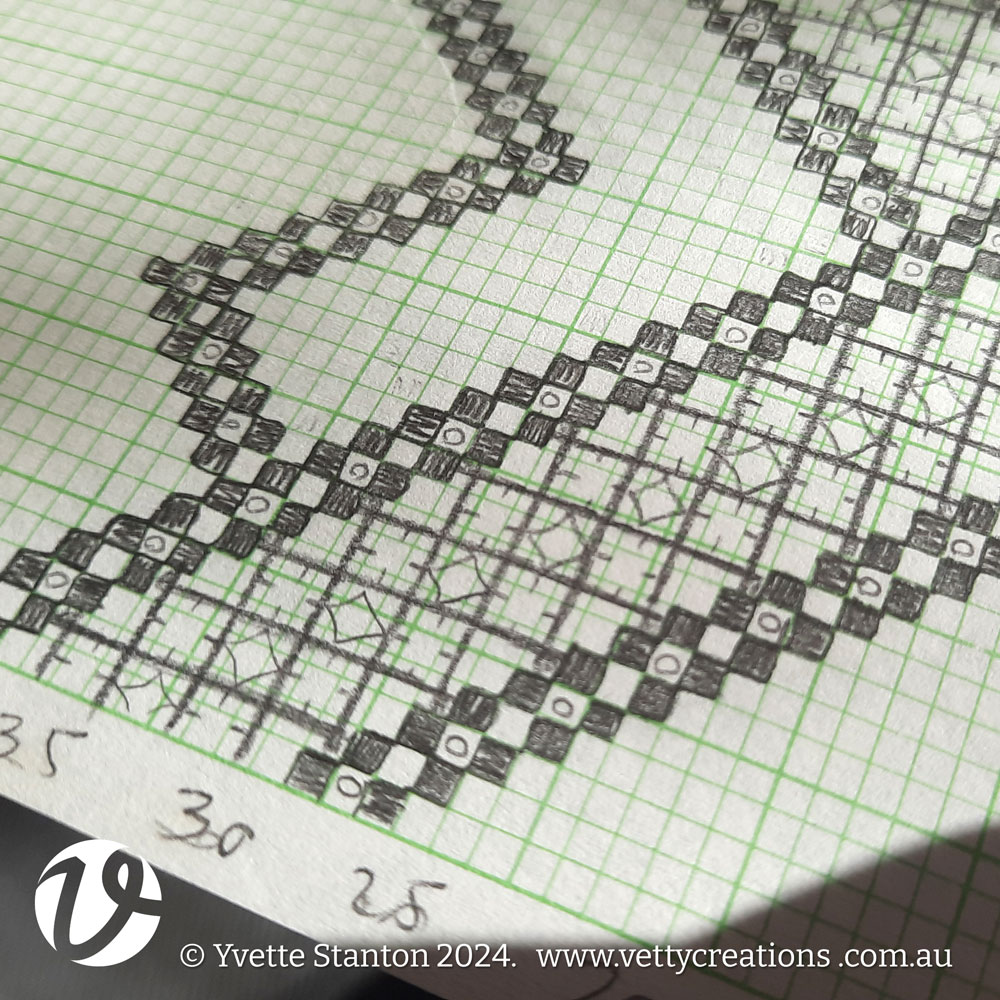On the weekend, I had a question from Christine, who has nearly completed the sampler in Hardanger Filling Stitches. She’s now feeling like she’d like to design some of her own Hardanger pieces. I’m all for this! If I can teach you how to work the stitches and that makes you confident enough to embark on some of your own designing, that makes me incredibly happy!
Christine said that she’s tried designing on graph paper, but the grid was too small and her hand was too shaky. So she was wondering about other possibilities like computer programs.
When I design I use Adobe Illustrator. It’s not a program for the faint-hearted because it’s not like programs where you just drop the motifs on a grid – you start with nothing and create everything from scratch. All my charts are created from a library of motifs that I have created and built up over many years.
There are cross stitch design programs that say they can also be used for designing Hardanger, but I’m pretty sure I’d find them quite limiting, with the motifs provided. I have never used any of them, so I can’t make any recommendations. But they do exist, so you could look into them. Some names which I have heard, which may or may not exist anymore and which may or may not be suitable for you, include StitchGraph, EasyGrapher, WinStitch, and there are possibly others.
What I want to show you is where I started with my Hardanger designing. I started on paper. Then I progressed to doing it on my computer in a limited way, and my charts have evolved over many years to become what they are today.
Often I started with a very rough sketch of what the whole design could be, just on plain paper. This helped me to work out the overall design.

sketch of hand towel ideas

Rough sketch of runner
Then I used graph paper to add detail and work out the basic counting. For this I usually used 2mm grid squares. For the 2mm graph paper, each square was equivalent to 12 x 12 threads (3 klosters wide and high), or when I wanted more detail, each square represented a 4 x 4 thread block.
For those of you who use imperial/US customary measurements, somewhere between 1 and 2mm is 1/16th of an inch, and 5mm is just less than 1/4 in. (Do you know how much easier it is to work with decimal measurements?! ?)

2mm squares. Each one represents a 12 x 12 block of threads; the span of 3 klosters.

2mm squares. Each one represents a 4 x 4 thread block.

2mm squares. Each square represents a 4 x 4 thread block.

2.5mm squares. Each one represents a 4 x 4 thread block.
You could also use 5mm grid squares instead of the 2mm squares. It will turn out larger, so you’ll need more graph paper, but it may mean that it’s a little bit easier for unsteady hands or impaired eyes.
I did have some 1mm graph paper, so sometimes I did really detailed charts, where each grid line represented a fabric thread. Steady hands and a sharp pencil really help here!

1mm squares. Each grid line represents one fabric thread.
This was a basic chart done on computer. It was done in Illustrator, but it wasn’t designed to show full detail. This was just for my reference, and I would never release a chart like this to the public as there’s too much assumed knowledge.

Basic chart on computer. Grid lines every 4 threads.
My later charts, done on computer, have more detail on them, so that you can stitch directly from them.

Current day style of my charts
All this is to show, you *don’t* need a computer to be able to design Hardanger embroidery. It can make it easier, because it’s easier to move things around the page and try them out without the copious amounts of erasing. However, if you don’t have the skills to do it on computer, the learning curve to figure it all out is far harder than using paper, pencil and an eraser. It can also be far cheaper to use paper, pencil and an eraser than buying a computer and the software to use on it!
A hand drawn chart is not considered suitable for publication, so if you need charts for publication, I am available to create freelance charts based either off hand drawn ones or stitched projects. I have done this in the past for other publications.

 White Threads is the blog of Yvette Stanton, the author, designer, publisher behind Vetty Creations' quality needlework books and embroidery products.
White Threads is the blog of Yvette Stanton, the author, designer, publisher behind Vetty Creations' quality needlework books and embroidery products.

Thank you Yvette! I’ve tried to design my own small projects like bookmarks in the past but made a hash of it. This is extremely helpful!
My pleasure, Karen!
Agree with Karen that your design process is enlightening. Thanks very much for letting us see the general procedure.
It’s easier if the software does it well. I had some, years ago, that claimed to do canvaswork and hardanger, but the results were so chancy with canvaswork I’d hate to have seen the mess I’d have got into with hardanger!
My understanding that most of these software programs are designed for charting cross stitch. They obviously want to expand their market by making them a bit suitable for Hardanger and canvaswork – but because they’re just sort of add-ons, it’s not as successful as it could be.
My pleasure, Donna!